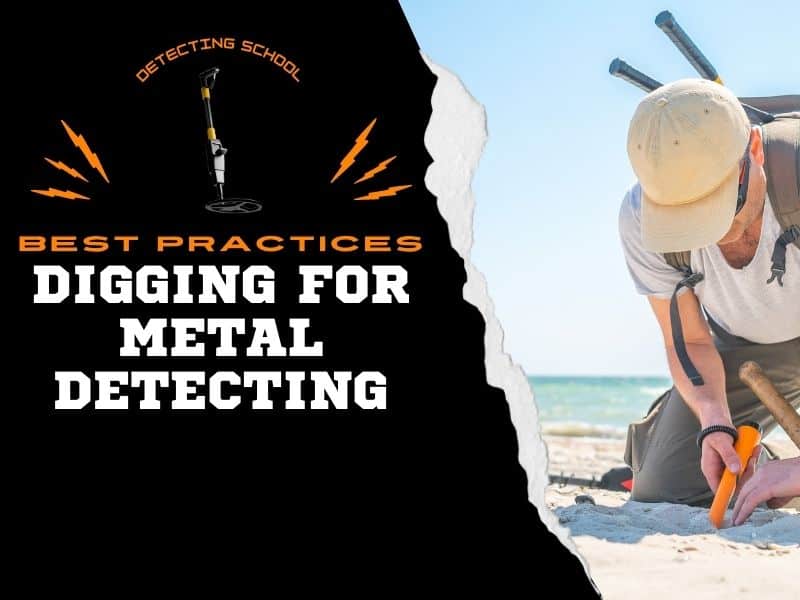
Metal detecting is not only about picking the right target signal, it is also about properly digging your target …
In this article, I share the most reliable digging techniques you should adopt alongside with the tools you should consider to make the process easy and effective.
Regardless of whether you are a seasoned detectorist or just starting out, you will find this short post useful!
Key Takeaways
- Digging techniques depends on the terrain you are dealing with. Digging in grass is not as digging agricultural land.
- Always considering environment while digging. This will help preserve the area and keep the hobby’s reputation in a good shape.
- You don’t have to dig at maximum depth each time. Factors like your metal detector coil size, soil conditions and potential targets can help you decide the digging depth.
Basic digging tools for metal detecting …
- Trowel: It is a small, handheld digging tool. You can use it to retrieve targets at shallow depths. This will help minimizing damage to the surrounding area.
- Digging knife (Check this example): A serrated knife which is designed to cut through roots and soil. This will make it easier for you to extract buried objects.
- Handheld spade or mini shovel: Very important if you want to dig larger holes, especially in tougher terrain, while keeping the excavation neat and manageable.
- Lesche digger (Like this): This one is quite popular among detectorists. Usually comes with a serrated edge and durable construction for efficient digging.
- Sand scoop: Very important for beach metal detecting. A sand scoop will help you sift through sand quickly, separate the target from the surrounding material. You can have a look at this selection of quality sand scoops.
- Knee pads: Even if you don’t have bad knees, this will provide you with the necessary comfort and protection while kneeling on the ground during the excavation process. Check my favorite knee pads.
Proper digging techniques for different terrains
As I’ve mentioned in the key takeaways, you should adopt different digging techniques depending on the terrain type you are dealing with:
1. Grass and parklands
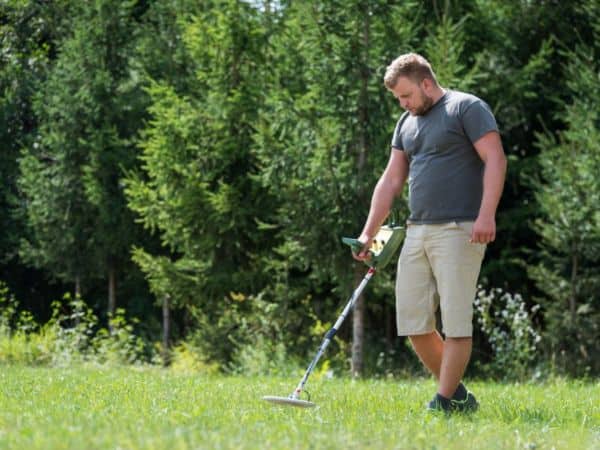
- You should use a small trowel or digging knife to make a neat (circular plug) cutting around the target area while leaving only one side attached as a hinge.
- Try to fold the plug to expose the soil beneath, then use a pinpointer (Learn about pinpointers) to accurately locate your target.
- Once you recover your object, try to carefully fold the plug back into place and press down gently. Ensure the grass remains intact.
2. Forests and wooded areas
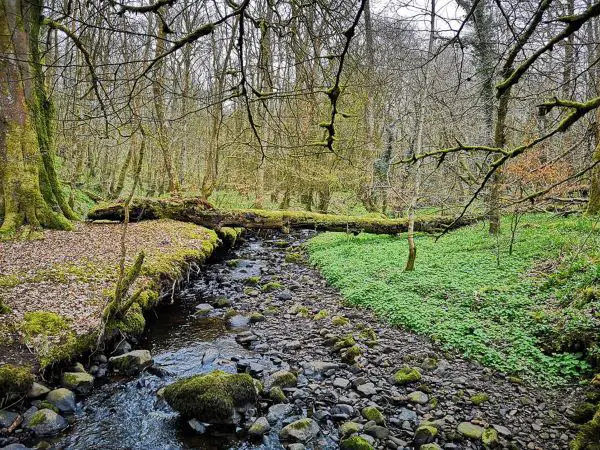
- Forest & wooded areas are generally full of tree roots. You will have to use a serrated digging knife or a Leashe digger to cut through those roots without causing a significant damage.
- You can use (if you prefer) a hand spade to dig around the roots to extract your target.
- Once done, refill the hole with excavated soil. Try to minimize any disturbance to the natural environment.
3. Fields and agricultural land
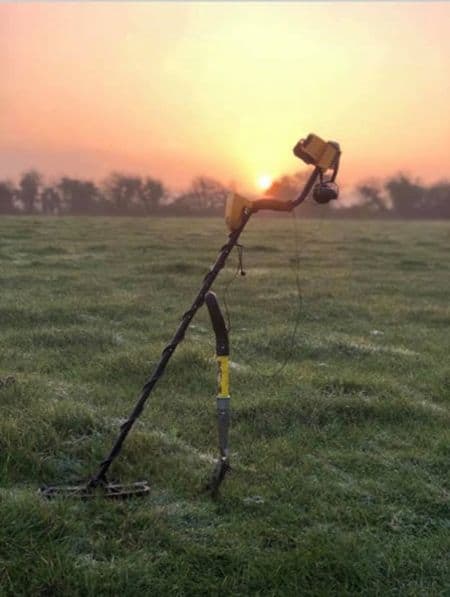
- Unless it is your land, don’t forget to get the landowner permission before you get started.
- You can use a hand spade or trowel to dig a round hole to remove any clods of soil to place them on a cloth or plastic sheet. This will help prevent any sort of contamination.
- After retrieving the target, carefully replace the soil and restore the surface to its original state.
4. Beaches and sandy areas

- Sand scoop is your best friend to deal with dry sand. It is very efficient when it comes to sifting through the sand to separate the target.
- For wet sand you can use a longer-handled sand scoop and a waterproof pinpointer (Check these examples) for easier target retrieval.
- When digging in sand, always refill holes to prevent hazards for other beachgoers.
5. Rocky or uneven terrain
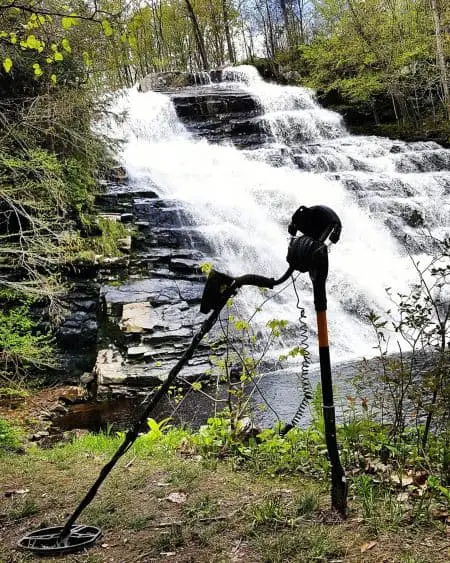
- To break through hard-packed soil or loosen rocks, you should utilize a small pickaxe or a rock hammer.
- Be cautious to avoid damaging your target or hurting yourself in the process.
- You can restore the area by replacing rocks and soil to minimize environmental impact.
How deep do you have to dig with a metal detector?
To answer this question, I probably need to write a brand-new article. But to keep it simple, you need to understand that the depth at which you should dig depends on things like your machine’s type, target, searchcoil and ground conditions …
For example, if you are targeting coins, then you can dig up to 10 inches (25 cm). Especially if you are using a coin shooting machine.
Larger objects could be detected even deeper, up to 2 feet deep.
Advanced metal detectors with larger coils can indicate that to you depending on the model you are using.
It is worth mentioning that factors like ground mineralization & conditions and your target orientations might significantly impact the detection depth & signal strength.
What is the fastest way to dig a hole?
There is a method called the “Detective Duo”. You will need to team up with a fellow detectorist and designate one person as the “Digger” and the other one as the “Spotter” …
The Spotter will only focus on pinpointing targets using the metal detector and then marking the locations. Then the Digger will keep excavating the market spots with a trowel, serrated digging knife or a Leshe Digger.
This coordinated effort will allow each person to focus on the role. This will dramatically enhance the productivity …
Not to mention that such a method empowers camaraderie & teamwork which will make the detecting experience efficient & enjoyable.
Of course, you can alter roles from time to time to avoid boredom.
How to pinpoint your target to make digging easier?
Using a pinpointer is, in most cases, a key tool for much effective digging. Try to follow these steps:
- Once your beloved metal detector produces a signal, start swing by gradually narrowing the search area from where the signal’s coming.
- Pay attention to the signal’s strength and try to identify the loudest audio response, which should indicate the target’s precise location.
- Use your pinpointer to further narrow down the target’s position. This will ensure a minimal digging would reducing the risk of damaging your find.
- Mark your spot and start digging using the appropriate tools depending on the terrain you are dealing with.
Properly filling in the holes and leaving no trace
This is probably the main reason why other people consider detectorists as being bad individuals. They don’t fill holes after digging. People who do so are totally against (metal detecting code) …
Try to follow these guidelines:
- Always have a drop cloth or small trap where you can place excavated soil or grass plugs. This will keep them intact and prevent any sort of contamination.
- Only create neat plugs or holes to minimize disruption of the targeted area.
- Once you’ve managed to retrieve the target, replace the soil or grass plug following the same order in which it was removed.
- Press down the replaced soil and make sure it looks almost the same as before.
- You can end the process by sweeping the area with your foot to make no visible trace of your digging activity.
Avoid this Mistake: One mistake that most detectorists do is that they prefer to keep digging many holes so they can come back to refill them. Well, that’s a bad idea! You’ll generally end up digging dozens of holes and you won’t feel like going back to refill all of them. And even if you do, you won’t do it as good of a job as it should be done.
Tips for preserving your finds during excavation …
Detectorists should not take the part related to preserving finds for granted. By doing so, they will protect their discovery and maintain its original value …
For this, you will have to dig carefully and avoid damaging the surrounding area. Try to dig in a way you feel that you are doing so around your target. Even if this means that you have to dig a little bit later hole, so be it …
Once done, use a soft brush to remove dirt & debris. Try not to scratch or damage the item.
- If your target is a metal, then you can store it in an airtight to prevent corrosion and damage.
- If you’ve found a coin, then avoid cleaning them as this can significantly lower its value. Just wipe it with a soft cloth.
Final Thoughts …
I’ve never asked something like this, But PLEASE, if you’ve found this article Useful, PLEASE PLEASE PLEASE share it with other persons. Most detectorists don’t care about this aspect of the hobby …
This gives a bad reputation for metal detecting which makes it harder for us to get detecting permissions & permits.
So PLEASE share this article in your social media and facebook groups and any other place.
THANK YOU!
